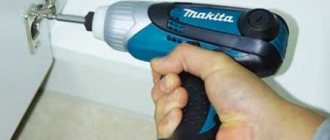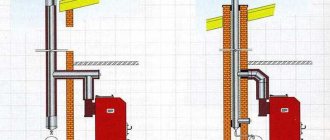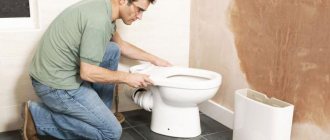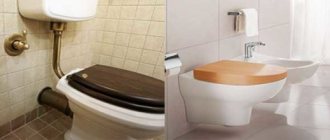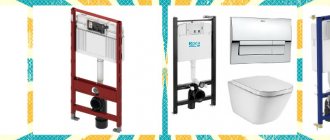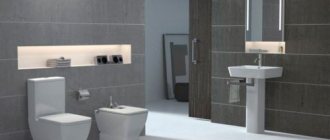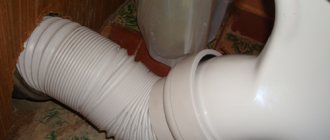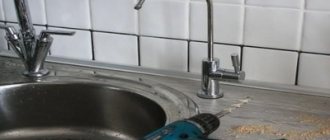When organizing a home, you have to solve a variety of issues, including choosing plumbing. It’s great if the bathtub and toilet are made in the same style. But if choosing a bathtub is quite simple, then when choosing a toilet the question often arises: which toilet is better with an oblique outlet or with a straight one. Release is an important factor in the separation of plumbing fixtures. Depending on the location of the connecting hole, it can be horizontal, vertical or oblique. In this article we will try to talk about the various nuances of choosing plumbing fixtures for a toilet room, and will dwell on the advantages and disadvantages of each type of product.
Oblique release
Oblique toilet outlet
The outlet device in such models is located with an angle maintained within 30-40°, and the most popular toilets with an oblique outlet in the “Brezhnevka” and “Khrushchev” buildings. In modern new buildings, a direct type connection is often found, but in this case it is quite acceptable to use plumbing fixtures that have an oblique outlet.
Model advantages:
- a very large selection of modifications;
- affordable cost of plumbing fixtures;
- maximum ease of self-connection;
- Possibility of connecting to a wide variety of output types.
Main disadvantages of the configuration:
- unsuitability of the design for connecting suspended models;
- a fairly high risk of sewer odors;
- the likelihood of splashes forming during draining.
In addition to the diversity of the model range and absolute versatility, the advantages of toilets with an oblique outlet include the ease of self-assembly of the device. The connection is made using a plastic adapter elbow, an eccentric, a flexible corrugated sleeve and waterproof silicone sealant.
Connection to sewerage
The connection option is determined by the type of release.
Connecting a toilet with an oblique or horizontal flush
An oblique or straight outlet is located at the back of the product. To connect, you need the following tools:
In order to connect plumbing equipment, you must do the following:
The corrugation used for connection can be replaced with ordinary plastic pipes, which are intended for sewerage. Selection of pipe sizes and bends is carried out on an individual basis.
Connecting a toilet with a vertical outlet to the sewerage system
To connect a toilet with a floor outlet to the sewerage system, you will need:
The connection of equipment and sewerage is carried out in the following way:
There are installers who prefer to use a regular rubber seal instead of a flange. Professionals do not recommend fixing a toilet with a floor outlet in this way, because fixing the rubber gasket does not make it possible to achieve the proper level of fixation of the equipment.
Following the rules for connecting the toilet outlet to the sewer pipe, installing sanitary equipment will not be difficult without involving professionals - you can easily do it yourself.
Source
Horizontal
Models of toilets with a horizontal outlet can be installed in the presence of a sewer pipe with an outlet at an oblique angle, but using special pipes. The device is installed close to the wall, which helps save space and make the appearance of such a plumbing fixture as aesthetically pleasing as possible. Standard cuffs are used to connect the toilet.
Model advantages
- guaranteed maintainability;
- affordable cost of plumbing fixtures;
- quite decent performance characteristics;
- Possibility of installation to corner devices with oblique outlet.
Main disadvantages of the configuration:
- the need to adapt corrugated adapters;
- the likelihood of reinstalling the sewer pipe;
- certain complexity of self-installation.
Today, floor-standing, suspended and attached models are equipped with horizontal outlets. The parallel arrangement is also characterized by some disadvantages, including difficulties during self-installation, the risk of frequent blockages and leaks in the areas where the plumbing fixture meets the sewer system.
Classifications of sanitary devices
Progress does not stand still - manufacturers systematically bring new varieties to the market. They can be classified into several groups based on criteria.
Depending on the location of fixation, it is customary to distinguish the following categories:
Manufacturers also make allowances for the age of their customers and offer:
The bowl in the equipment may differ in shape:
The drainage system has differences, and manufacturers have gone as far as possible in this matter. The following options are available:
A common question is the availability of side release devices. The reasonableness of such a question occurs only if you have to deal with very small dimensions of the bathroom. The ingenuity of our people is truly limitless, and the side release is proof of this. The thing is that if you place the toilet on its side, you can easily free up the space needed to install a washing machine.
So, such varieties have not yet gone on official sale today, but if you wish, you can literally do everything with your own hands. To ensure lateral descent, adapters can be used. On horizontal sections, you should make a 90-degree turn out of two 45 degrees, although some recommend 90 degrees at once, just to ensure a slope.
Universal
A feature of the functional universal design of the toilet outlet is the removal of sewage and domestic water using various elements that provide a transition to the wall or floor. On toilets with a universal outlet type, the outlet pipe is located in a horizontal position at the rear of the structure. The price for such models is usually noticeably higher.
Model advantages:
- operational comfort;
- absence of unpleasant sewer odors;
- maximum convenience of independent repair work;
- Possibility of use with different sewerage options.
Main disadvantages of the configuration:
- the need to use adapters for installation in the floor or riser;
- high cost of imported sanitary products;
- some maintenance problems.
Due to their design features, plumbing fixtures with a universal outlet option are successfully used in sewer systems of various types. Thanks to correctly selected adapters and the ability to make an easy, quickest independent connection, universal releases are in high demand.
Main types of toilet release
Types of connecting elements
If it is impossible to directly connect the toilet to the sewer due to the design features, auxiliary materials are used - connecting pipes. In most cases, the following types are used:
Connecting the toilet to the sewer with corrugated pipes is used if the alignment of the pipes is not maintained. The advantage of this type is the ability to install the product at an arbitrary angle.
The disadvantages of using corrugations to connect the toilet to the sewer include the large minimum length. If the distance between the pipes is about 12 cm, it is better to opt for other connecting components.
This data will allow you to choose the most suitable cuff model in the store. The disadvantage of the eccentric part is its short length, which implies the possibility of installation only with a small distance between the nozzles (up to 12 cm).
Bends and corners are installed in cases where the corrugation cannot be used for some reason. Their advantage compared to corrugation is that the wall is smooth on the inside, which significantly reduces the risk of blockages.
The main disadvantage is rigidity, which leads to leakage even with a slight misalignment. Plastic products can be cut to fit, unlike cast iron.
In most cases, steel pipes are used when there is a risk of failure of the water seal mechanism (find out what a water seal for sewerage is, its operating principles, what types there are, etc.). If the throughput of the riser is insufficient, liquid from the siphon will be drawn into it.
As a result, the water seal does not work, and the stench from the sewer enters the room. In such a situation, a pipe product with an automatic valve is connected to the riser or pipe connected to the toilet. When draining, a special valve opens and air enters, which prevents the water seal from breaking.
However, to implement such a function it is not necessary to use steel pipes. There are also eccentrics and adapters that give the pipeline similar properties. To ensure reliable connection, it is recommended to use sealant when using any type of connecting elements.
For these purposes, it is advisable to purchase a special waterproof product intended for plumbing fixtures. By loosening the rubber sealing collar, the sealant will prevent leakage.
Corrugated connection
As a rule, installation of a toilet with direct and oblique outlet is carried out using corrugation. It has an affordable price, can be bent in any direction and used as a temporary connecting element. When purchasing, you should focus on the length from the sewer outlet to the toilet outlet; the corrugation should be a third larger than this value.
What is a toilet flush? This is a drain hole that connects the apartment’s plumbing to the sewer system. There are three varieties - horizontal, vertical and oblique drain outlet.
If a small leak (a few drops) was detected during the last test, all liquid must be completely removed and the corrugation removed. Then apply silicone again to the elastic band of the product and install it on the toilet pipe.
Find out what you need to do if the toilet tank suddenly starts leaking: 9 reasons why it is leaking and video instructions for repair.
Release to the floor
The vertical location of the outlet part allows the toilet to be installed even in conditions of insufficient free space, in small plumbing rooms. The most important difference in the configuration is the presence of a siphon and pipe already built into the product itself. Installation of these models can be done in a variety of ways, which is explained by the lack of connection to the wall.
Model advantages:
- optimal design for a private home;
- Possibility of installation almost anywhere;
- masking the sewer line under the floor;
- maximum convenience of inspection and repair of the output part.
Main disadvantages of the configuration:
- inappropriate layout of the sewer system;
- high cost of professional repair and installation services;
- The cost of the plumbing itself is quite high.
The undeniable advantages of the model range with floor outlet include the ease of choosing a place for installation, installation compactness, the availability of sufficient free space for the installation of additional plumbing fixtures and furniture, high efficiency of the flushing system, the absence of water splashes during the draining process, as well as guaranteed strength and reliability designs.
Dismantling old elements
Before connecting the toilet to the sewer pipe, the installation site should be cleared of elements of the previous structures. The procedure is carried out using a hammer, screwdriver and pry bar.
In most cases, the outlet of old products is built into a cast iron structure (“elbow”), which requires breaking the pipe with a hammer. When performing this procedure, be sure to wear safety glasses. Otherwise, sharp ceramic shards will get into your eyes, causing injury.
To remove small parts, a screwdriver and a hammer are enough, but for large elements you will need to use a pry bar. When tapping with a hammer, it is important not to overdo it, because... strong impacts will lead to the splitting of the cast iron socket.
In this case, you will need to break the floor to get to the sewer riser. Then you will need to connect the new outlet to the riser.
When the main deposits have been removed, you can begin the final stage of cleaning the pipeline. To do this, you need to coat them with a special chemical for cleaning the toilet, and then scrape off the residue using a wire brush.
Finish cleaning with a rag. The first 5-6 cm of the cast iron socket must be completely smooth from the inside, because the absence of leaks in the future and the tightness of the joint depend on this. The entire procedure must be carried out wearing protective gloves.
Wall-hung toilet
Installations today do not fall into the category of common toilet models, so connecting them is often difficult. Wall-hung plumbing fixtures are installed using a support structure in the form of a metal frame to secure the flush cistern and bowl. Installation and finishing make it possible to make only the toilet bowl and cistern button visible, and the piping system of frame and block structures is covered with finishing materials.
Model advantages:
- operational comfort;
- almost silent operation;
- absence of unpresentable appearance of risers;
- the ability to select a device to match the overall style.
Main disadvantages of the configuration:
- difficulty in choosing the optimal connection scheme;
- high cost of plumbing fixtures;
- complexity of audit and maintenance.
Each kit is complemented by a detailed connection diagram to the sewer pipe, and installation problems may be caused by the location of the toilet outlet, which is completely incompatible with the inlet in the tee. Under such conditions, a suspended model is connected to the sewer network using a flexible pipe. Corrugation allows you to connect elements located in different planes, but also lengthens the outlet section, which is not always necessary when installing an installation.
Drain system
The toilet tank is probably the main structure. The functioning of the unit depends on its operation. Without a cistern, a toilet is nothing special. There are many types of tanks, and you need to be able to make your choice correctly.
Toilet flush tank
There are two types of flushing mechanism in tanks:
- Single-mode.
- Double drain.
In the first option, we press a button or pull a string, and all the water rushes into the toilet. If you want to save water, which is especially important if you have a water meter, then it is advisable to install a double flush mechanism. This model usually has a double button. If you press one, all the water pours out of the tank; when you press the second, only half of the tank is emptied.
Tanks with another “stop mode” have appeared on sale. In this case, there is only one button, the first time you press it, the flush starts, and if you press the button again, it stops.
The buttons can also be located in different ways: on the tank lid, on the side wall or on the front panel.
Depending on how the water is distributed, the drainage can be:
- Straight;
- Back.
We see the direct option in our apartments most often, because it is practiced in domestic toilets. After pressing the button, water is directed into the toilet bowl in a large flow. In this case, a lot of noise is heard and a large amount of splashes is generated.
Using the toilet
Foreign plumbing has a reverse drain. In this case, the water is supplied in an arc, and its flow evenly washes the entire bowl, while all this happens almost silently. Not only the absence of noise distinguishes such a system, but also the economical use of water.
Toilet bowls may also differ in the type of flush. It is very important for us that everything that ends up in the toilet is removed from there without leaving a trace. This directly depends on the direction of the water jet. It can come out in different ways:
- Cascade drain;
- Shower.
In the first option, water will wash the entire bowl along the inner walls. During the shower, it rushes along the perimeter of the bowl and forms a funnel into which the entire contents of the bowl are drawn.
You can find another system in which water first fills the toilet almost completely, and then it all suddenly rushes into the sewer. Of course, this option is not very economical, although there are models with an economical mode.
Which release is better?
The most popular in the Russian Federation and the post-Soviet space are toilets with a standard oblique outlet. In accordance with all currently valid standards and requirements for the preparation of standard design documentation for the arrangement of sewer networks in residential and administrative buildings, the pipes are intended for the installation of plumbing fixtures that have an oblique type outlet. The optimal option is considered to be not only models that meet these requirements, but also devices with a universal connection type. Such toilets provide complete freedom in planning the plumbing room.
Modern installations deserve special attention. Wall-hung toilets provide maximum hygiene and stylish room design, but are quite difficult to install and are installed in accordance with certain rules, so it is advisable to refrain from installing them yourself. Thus, the waste part of the toilet must strictly correspond to the type of location of the sewer pipe outlet in the plumbing unit, but if necessary, it is always possible to use models with a universal drain outlet option.
Step-by-step installation instructions
After dismantling the previous structure and cleaning the sewer inlet, you can begin installing the toilet. The complexity of this procedure depends on the design of the plumbing fixture.
Toilet with vertical outlet
Due to the absence of the need to leave some free space behind the toilet to install pipeline fittings, the model can be mounted at a minimum distance from the wall. The procedure begins after dismantling the previous plumbing components and completely cleaning the area where the new product will be installed.
Stages of installing a toilet in a cast iron sewer:
Sometimes it is necessary to carry out a horizontal displacement of a toilet of this type. This can be done without damaging the ceiling and moving the ladder in the room on the ground floor. However, you should understand that you will need to sacrifice 15-20 cm of height, because it is necessary to lift the product onto a small pedestal.
Important points to consider when performing the procedure:
Toilet with direct release
Watch the video - how to connect a bathroom with a horizontal (direct) outlet at home
This type of product is connected to the pipeline using a corrugated product, an eccentric collar or a strong, rigid structure made from a steel pipe.
This structure should not move when inserting the toilet outlet; it should be held by hand when performing the procedure. It is quite difficult to do this on your own; it is better to ask for help to prevent the structure from moving.
If the plumbing outlet matches the shape and height of the socket, then connecting a toilet with a horizontal outlet to the sewer is quite simple. In such a situation, the joint should be sealed using a cuff and a waterproof product - sealant for plumbing fixtures.
It is recommended to seal the connection between the toilet and the sewer pipe, because... The horizontal connection method assumes that water will be located directly at the joint, so every crack can become a source of leakage.
The main disadvantage of a toilet with direct outlet is that such a model can only be connected to the sewer through a vertical riser. The main advantages of this model include simplicity and ease of installation (you can quickly do it yourself), as well as the possibility of installation with a cast iron or plastic pipeline.
Standards according to GOST
of GOST 30493-96 , which set out the requirements for sanitary ceramic products and indicate the standard sizes of typical toilets: dish-shaped, funnel-shaped and visor, can also serve as a hint
Dimensions are indicated for models with oblique and straight outlet, with and without a solid molded shelf.
Two variants of the schemes presented in the regulatory documentation - with an attached and a solid-cast shelf. The sizes of the devices differ, but not dramatically
To better understand the circuits of standard models, you can use the information given in the table.
The table shows the standards for the length, width and height of toilets with/without a shelf, and the dimensions of children's products are listed in a separate line
If you combine the data, you get the following dimensions:
- Toilets with central shelf – 60.5*34-36*37-40 cm (l*w*h)
- Toilets without a shelf – 46*34-36*37-40 cm (l*w*h)
- Children's models – 40.5*29*33.5 cm (l*w*h)
Of course, now GOST standards are not mandatory for the manufacture of sanitary products; many companies produce toilets according to specifications, which must be reported in the technical passport.
Accordingly, the dimensions will differ from those stated above.
Samples of possible standard sizes. How close the dimensions of a plumbing fixture are to the standard can be found out by studying the drawing - it must be attached to the technical data sheet along with the installation diagram
It is impossible to force all kinds of design models, as well as products for people with disabilities, into a certain framework.
But most of the products presented in stores are still “standard” size toilets with a tank, that is, ordinary compact toilets priced at 7,000-15,000 rubles.
Non-standard toilet sizes: models for the disabled and devices with additional functions
For people of large build, appropriate toilet sizes are selected, which are characterized by increased dimensions. Such options are intended for people with a large weight or a height of 190 cm. When choosing a model, you should give preference to an option that can withstand increased load. Often, enlarged toilet models are designed to weigh 600-650 kg. The standards for the height of the toilet from the floor in this case will differ from the generally accepted ones and usually reach 65-70 cm, the length of the models is from 70 cm, and the width is 40 cm or more.
Helpful advice! If retail outlets do not find the optimal toilet size corresponding to the area of the room, you can make a piece of plumbing fixtures to order, taking into account the necessary parameters.
Most often, non-standard toilets are made to order for people with disabilities. In this case, it is necessary that the device not only be larger in size, but also be equipped with special handrails and a seat. The height of such models is 15-20 cm more than standard options. If the toilet is used by a wheelchair user, the height of the seat should not exceed the dimensions of the wheelchair. Typically this parameter is 50-60 cm. The same toilet dimensions are recommended for use by older people.
For people with disabilities, toilets of non-standard sizes and characteristics are ordered
Toilets with a built-in bidet may also have non-standard sizes. In most cases, these models are long due to their special elongated shape, because the shower head is conveniently mounted on the headband. The toilet cistern with bidet also has larger dimensions compared to standard ones. The length of the models is usually about 70 cm, and the width is 40-41 cm. The suspension system has smaller dimensions: width – 29-36 cm, and length – 52-60 cm.
Distances
It’s good for those who have a large room allocated for a bathroom or toilet. If yours is not so large, you need to know the minimum tolerances for the distance from the toilet to nearby “structures” and devices.
Distance from the toilet to the wall: according to standards - at least 25 cm
- There should be at least 25 cm between the bidet and the toilet.
- There must be at least 60 cm of free space in front. That is, the distance from the edge of the bowl to the door or wall in front is 60 cm or more.
- There should be at least 25 cm of free space on the sides. This is not enough, but tolerable. Comfortable distance - 35 cm.
Now you draw a plan of your bathroom, mark the minimum distances and see what size toilet will fit into your toilet. So it's simple.
How to choose a lid and toilet seat
To choose a suitable toilet seat, you need to know exactly the dimensions of the plumbing fixtures. It is believed that the lid should exceed the dimensions of the toilet by about 0.5 centimeters , however, this is not a necessary condition. To make accurate measurements, you need to find out three main parameters:
- Distance between mounting holes.
- The length from the fastening axis to the end of the cover.
- Distance from the mounting axis to the outer rim of the toilet.
In addition, you need to take into account an important nuance: the shape of the lid must match the rim of the toilet.
Seat - pad with handrails
Convenient modifications of lids with handles are provided for disabled people:
What is this mysterious microlift?
For ease of use of plumbing fixtures, additional accessories are sometimes included in the design of the toilet. One of these elements is a microlift. According to technical parameters, a microlift is similar to a regular door closer and performs similar functions. The task of the microlift is to ensure smooth lowering of the lid onto the toilet rim, excluding sharp impacts that can damage the toilet seat and ceramics.
Toilets with a microlift can be found in any plumbing store; the installation of this element has virtually no effect on the cost of the product.




